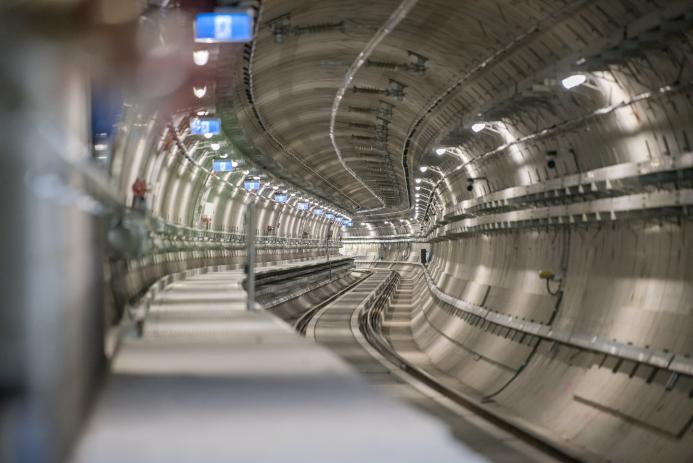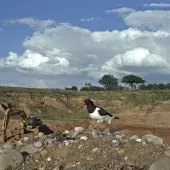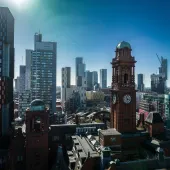Melbourne’s MTP promotes sustainable concrete innovations
The AU$11 billion (£5.68 billion) Melbourne Metro Tunnel Project’s innovative approach to sustainable concrete solutions has avoided thousands of tonnes of carbon emissions and contributed significantly towards the project’s target of diverting 90% of construction waste from landfill.
The Metro Tunnel Project, in Melbourne, Victoria, Australia is delivering twin 9km-long rail tunnels between South Kensington (northwest of the Melbourne central business district) and South Yarra (in the southeast) with five new underground stations designed by architects RSHP, Hassell and Weston Williamson.
The new stations will feature 230m-long platforms, large concourses, and full-height platform-screen doors, a first for Melbourne. Three of the new stations – Arden, Parkville, and Anzac – are cut-and-cover box designs and involved digging down to build the station.
The two Central Business District (CPD) stations – State Library and Town Hall – are mined stations built using a unique "trinocular" construction method of three overlapping caverns dug by road headers and featuring high ceilings, an arched vault design and 19m-wide platforms.
The tunnel will connect the Pakenham and Cranbourne lines with the Sunbury line, creating a new high-frequency cross-city line that bypasses Flinders Street station and the City Loop. The line is also planned to serve Melbourne Airport via a new branch line west of Sunshine.
The project, part of Victoria’s Big Build program, is the largest upgrade of Melbourne’s rail network in four decades and includes five new underground stations, constructed to a five-star Australian Green Star Design and As Built rating and aligned to the United Nations Sustainable Development Goals.
Concrete works
Since initial construction works commenced in early 2017, the project has poured 727,000 cubic metres of concrete to build the new tunnels and stations, with Environmental Product Declarations (EPDs) supplied for 210,000 cubic metres (29%) of concrete used.
The project’s tunnels and stations contractor, Cross Yarra Partnership Design & Construction (CYP D&C), which includes Lendlease Engineering, John Holland, Bouygues Construction and Capella Capital, has had a strong focus on recycling and reusing materials during construction.
As a result, this part of the project has achieved a current concrete cement reduction of 52% and saved more than 179,000 tonnes of fresh cement to date (when compared to the Green Building Council of Australia’s concrete mix reference case).
More than 97,000 cubic metres of pre-cast concrete has been poured into the tunnel segments, including a mix design with 42% slag as supplementary cementitious materials.
More than 340,000 cubic metres of construction waste has been diverted from landfill and almost 2.2 million cubic metres of uncontaminated soil has been reused.
Smaller carbon foorprint
At the two new train stations in Melbourne’s CBD (of State Library and Town Hall), CYP D&C has used an inventive cement replacement within shotcrete and permanent lining, alongside the use of steel fibre in sprayed concrete instead of traditional steel mesh, and the application of synthetic fibre to sprayed concrete linings, reducing the overall amount of materials and excavation required.
These innovative approaches have reduced the carbon footprint of concrete use, resulting in an overall reduction of 49.2% in the Portland cement content of concrete for the State Library and Town Hall stations.
Elsewhere, CYP D&C concrete mixes have avoided 156,000 tonnes of carbon (CO2) emissions via Portland cement reductions of between 25% and 70% in elements such as tunnel segments, piling, walls, and roof slabs.
At one station innovative research trials were undertaken on temporary S32 suspended slabs constructed from a concrete aggregate that replaced 25% of virgin sand with waste-based crushed glass.
This joint trial by CYP D&C and the University of Melbourne could lead to future tests that increase the sand replacement up to 50% crushed glass, with plans for future trials in low-risk permanent applications.
To date, the MTP’s tunnels and stations have achieved a 51.8% Portland cement reduction (above the Victorian Government’s 36% project reduction target) and avoided CO2 emissions greater than 156,000 tonnes - equivalent to taking an average 34,000 cars off the road per year.
The Metro Tunnel will open to passengers in 2025.
For more, visit the Big Build website.








